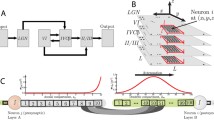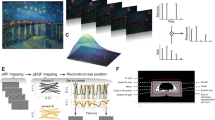Abstract.
A kinematical model for excitable wave propagation is analyzed to describe the dynamics of a typical neurological symptom of migraine. The kinematical model equation is solved analytically for a linear dependency between front curvature and velocity. The resulting wave starts from an initial excitation and moves in the medium that represents the primary visual cortex. Due to very weak excitability the wave propagates only across a confined area and eventually disappears. This cortical excitation pattern is projected onto a visual hemifield by reverse retinotopic mapping. Weak excitability explains the confined appearance of aura symptoms in time and sensory space. The affected area in the visual field matches in growth and form the one reported by migraine sufferers. The results can be extended from visual to tactile and to other sensory symptoms. If the spatiotemporal pattern from our model can be matched in future investigations with those from introspectives, it would allow one to draw conclusions on topographic mapping of sensory input in human cortex.
Similar content being viewed by others
Explore related subjects
Discover the latest articles and news from researchers in related subjects, suggested using machine learning.Author information
Authors and Affiliations
Additional information
Received: 25 April 2002 / Accepted: 20 February 2003 / Published online: 20 May 2003
RID="*"
ID="*" Present address: M. A. Dahlem Leibniz-Institut für Neurobiologie, Brenneckestr. 6, 39118 Magdeburg, Germany
Acknowledgements. We would like to thank V. Zykov for useful discussions on wave Propagation, and one of us (MAD) would like to thank Ed Chronicle for useful discussions on functional excitability. This project was supported by a scholarship Landesstipendium Sachsen-Anhalt to MAD.
Correspondence to: M. A. Dahlem (e-mail: dahlem@ifn-magdeburg.de)
Rights and permissions
About this article
Cite this article
Dahlem, M., Müller, S. Migraine aura dynamics after reverse retinotopic mapping of weak excitation waves in the primary visual cortex. Biol. Cybern. 88, 419–424 (2003). https://doi.org/10.1007/s00422-003-0405-y
Issue Date:
DOI: https://doi.org/10.1007/s00422-003-0405-y




